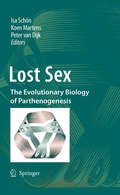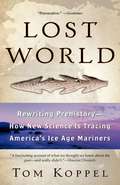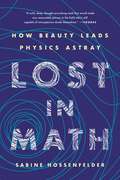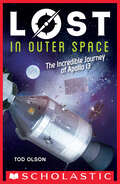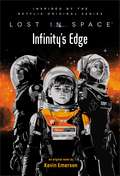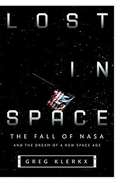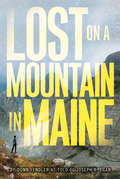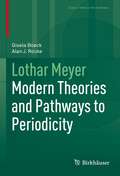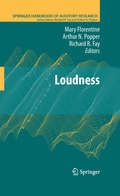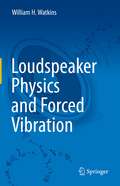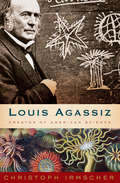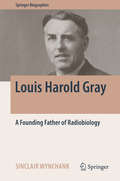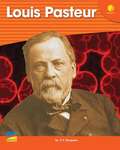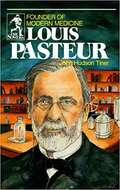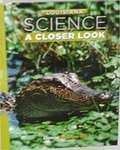- Table View
- List View
Lost Sex
by Isa Schön Peter Van Dijk Koen MartensSex is the queen of problems in evolutionary biology. Generations of researchers have investigated one of the last remaining evolutionary paradoxes: why sex exists at all. Given that sexual reproduction is costly from an evolutionary point of view, one could wonder why not all animals and plants reproduce asexually. Dozens of contemporary hypotheses attempt to explain the prevalence of sex and its advantages and predict the early extinction of fully asexual lineages. The major theme of this book is: what is the fate of animal and plant groups in which sex is lost? Initial chapters discuss theory behind asexual life: what major disadvantages do asexual groups have to face, what are the genetic and ecological consequences and what does this theory predict for more applied aspects of asexual life, for example in agricultural pests, diseases as well as in cultural crops such as grapes. Cases studies in many animals (focusing on both invertebrates and vertebrates) and plants reveal parallel, but also singularly novel adaptations to the absence of meiosis and syngamy. And last but not least, are asexuals really doomed to early extinction or do genuine ancient asexuals exist? This book assembles contributions from the most important research groups dealing with asexual evolution in eukaryotes. It is a milestone in research on parthenogenesis and will be useful to undergraduate as well as graduate students and to senior researchers in all fields of evolutionary biology, as the paradox of sex remains its queen of problems.
Lost World
by Tom KoppelFor decades the issue seemed moot. The first settlers, we were told, were big-game hunters who arrived from Asia at the end of the Ice Age some 12,000 years ago, crossing a land bridge at the Bering Strait and migrating south through an ice-free passage between two great glaciers blanketing the continent. But after years of sifting through data from diverse and surprising sources, the maverick scientists whose stories Lost World follows have found evidence to overthrow the "big-game hunter" scenario and reach a new and startling and controversial conclusion: The first people to arrive in North America did not come overland -- they came along the coast by water. In this groundbreaking book, award-winning journalist Tom Koppel details these provocative discoveries as he accompanies the archaeologists, geologists, biologists, and paleontologists on their intensive search. Lost World takes readers under the sea, into caves, and out to the remote offshore islands of Alaska, British Columbia, and California to present detailed and growing evidence for ancient coastal migration. By accompanying the key scientists on their intensive investigations, Koppel brings to life the quest for that Holy Grail of New World prehistory: the first peopling of the Americas.
Lost in Math: How Beauty Leads Physics Astray
by Sabine HossenfelderA contrarian argues that modern physicists' obsession with beauty has given us wonderful math but bad science Whether pondering black holes or predicting discoveries at CERN, physicists believe the best theories are beautiful, natural, and elegant, and this standard separates popular theories from disposable ones. This is why, Sabine Hossenfelder argues, we have not seen a major breakthrough in the foundations of physics for more than four decades. The belief in beauty has become so dogmatic that it now conflicts with scientific objectivity: observation has been unable to confirm mindboggling theories, like supersymmetry or grand unification, invented by physicists based on aesthetic criteria. Worse, these "too good to not be true" theories are actually untestable and they have left the field in a cul-de-sac. To escape, physicists must rethink their methods. Only by embracing reality as it is can science discover the truth.
Lost in Outer Space: The Incredible Journey of Apollo 13 (Lost #2)
by Tod OlsonFor middle grade space enthusiasts, the amazing true story of the doomed Apollo 13 moon mission that nearly ended in disaster.April 13, 1970: Two hundred thousand miles from Earth and counting, an explosion rips through Jim Lovell’s spacecraft. The crippled ship hurtles toward the moon at three times the speed of sound, losing power and leaking oxygen into space. Lovell and his crew were two days from the dream of a lifetime—walking on the surface of moon. Now, they will count themselves lucky to set foot on Earth again. From “Houston, we’ve had a problem” to the final tense moments at Mission Control, Lost in Outer Space takes readers on the unbelievable journey of Apollo 13 and inside the minds of its famous and heroic astronauts. Complete with photographs of the crew and diagrams of the spacecraft, this is an up-close-and-personal look at one of the most thrilling survival stories of all time.“Fans of action-packed true survival stories will take to this real-life space episode—an easy pick for upper elementary schoolers.” —School Library Journal
Lost in Space: Infinity's Edge (Lost in Space #2)
by Kevin EmersonThe second thrilling, original novel based on Netflix's smash hit Lost in Space! This all-new story focuses on twelve-year-old Will Robinson and his closest friend and greatest protector--a mysterious Robot with a dangerous past.The Robinsons--Will, his two teenage sisters, and their parents--are members of a colonist group who had been traveling across the galaxy to establish a new home, only to have had their ship attached and stranded on an alien planet. Just when they had finally managed to get off-world, the Robinsons were thrown off course yet again and were sent drifting toward an unknown location.Now, six months later, the Robinsons are stuck on an inhospitable water planet with no contact from their fellow colonists or from Will's beloved Robot. The twelve-year-old doesn't have any friends in his new home, until he discovers a mysterious girl...from the future. Her name is Clare, and she desperately needs Will's help to save her family. Will is eager to bond with his new friend, but--little does he know--something sinister lurks just beneath her surface. Can Will find a way to help Clare while keeping his own family safe?© 2020 Legendary. All Rights Reserved.
Lost in Space: The Fall of NASA and the Dream of a New Space Age
by Greg KlerkxThe daring, revolutionary NASA that sent Neil Armstrong to the moon has lost its meteoric vision, says journalist and space enthusiast Greg Klerkx. NASA, he contends, has devolved from a pioneer of space exploration into a factionalized bureaucracy focused primarily on its own survival. And as a result, humans haven’t ventured beyond Earth orbit for three decades. Klerkx argues that after its wildly successful Apollo program, NASA clung fiercely to the spotlight by creating a government-sheltered monopoly with a few Big Aerospace companies. Although committed in theory to supporting commercial spaceflight, in practice it smothered vital private-sector innovation. In striking descriptions of space milestones spanning the golden 1960s Space Age and the 2003 Columbia tragedy, Klerkx exposes the “real” NASA and envisions exciting public-private cooperation that could send humans back to the moon and beyond.
Lost in Wonder: Imagining Science and Other Mysteries
by Colette BrooksHow do we make sense of the modern world? Science is a profoundly affecting aspect of contemporary life, and yet the gulf between experts and everyone else is widening. Colette Brooks bridges the gap by playing the role of curious layperson, serving as a tour guide to some of the most important discoveries and innovations of the last five centuries.Through serious and absurd stories alike, Brooks takes readers back and forth in time, from dark, cavernous laboratories to the pristine facilities of the twenty-first century. Laugh along with Newton, peer at the moon with Galileo, work beside the Wright Brothers, ride with the astronauts of Apollo 11, watch for UFOs in the 1950s, probe the secrets of the fruit fly, visit Chernobyl, or examine suspicious packages in a Hazmat suit. With Brooks as the guide, it's easy to become immersed in the twists, turns, and surprises of each imaginative leap forward.Through a series of "thought experiments," Brooks also poses questions and offers helpful tips that ease the reader's way into this strange but provocative territory. Bringing her unique perspective to the larger cultural conversation about science, Brooks ultimately unleashes the most powerful force of all: our own wonder.
Lost on a Mountain in Maine
by Donn Fendler Joseph EganAll he had was hope.When twelve-year-old Donn Fendler gets tired of waiting for his father and brothers to join him on the summit of Maine's highest peak, he decides to find his own way back to camp. But Donn doesn't expect a fast-moving fog to obscure his path, knocking him completely off course. He doesn't count on falling down an embankment that hides him from sight. And he never could have imagined taking a wrong turn that leaves him alone to wander aimlessly for nearly two weeks in the empty mountain wilderness.A true and inspiring story about a boy's harrowing journey through nature's unforgiving terrain.
Lothar Meyer: Modern Theories and Pathways to Periodicity (Classic Texts in the Sciences)
by Alan J. Rocke Gisela BoeckThis book provides an English translation of the early fundamental contributions of Lothar Meyer (1830-1895) regarding his independent discovery, coincident with that of Dmitrii Mendeleev, of the periodic system of the elements. Although an English translation of the 5th edition of Meyer´s book Modern Theories of Chemistry and their Significance for Chemical Statics was published in 1888, this will be the first time that these crucial early texts will be available in English. These writings reveal details regarding Meyer´s research pathway to the idea of periodicity and to an arrangement of the chemical elements in tables and graphs.An introductory commentary and interpolated editorial footnotes to the texts clarify the (physico)-chemical background regarding the various shifts in thought during the crucial period from 1860 to the early 1870s. A short biography of Lothar Meyer completes the book.The volume includes a complete translation of the first edition of Modern Theories of Chemistry and their Significance for Chemical Statics (1864), the ground-breaking paper “The Nature of the Chemical Elements as a Function of their Atomic Weights” in Annalen der Chemie und Pharmacie, suppl. vol. 7 (1870), 354-64, and portions of the revised second edition of Modern Theories of Chemistry and their Significance for Chemical Statics (1872).
Lothar Meyer: Moderne Theorien und Wege zum Periodensystem (Klassische Texte der Wissenschaft)
by Alan J. Rocke Gisela BoeckDieser Band stellt die grundlegenden Beiträge von Lothar Meyer im Zusammenhang mit seiner Entdeckung des Periodensystems vor, die zwar fast zeitgleich, aber unabhängig der von Dmitrij I. Mendeleev erfolgte. Dafür wurden folgende Texte ausgewählt: Die modernen Theorien der Chemie und ihre Bedeutung für die chemische Statik. 1. Auflage (1864); Annalen der Chemie und Pharmacie, VII. Supplementband (1870) und Auszüge aus der zweiten Auflage des Werkes Die modernen Theorien der Chemie und ihre Bedeutung für die chemische Statik (1872). Anhand dieser Texte zeigen die Kommentatoren Meyers Weg zur Erkenntnis der Periodizität der Eigenschaften der Elemente und deren Anordnung in einer Tafel und in einem Graphen. Im einführenden Kommentar stellen sie neben der Biographie von Meyer viele Details zum physikochemischen Hintergrund und zu Veränderungen in den chemischen Theorien der 1860er- und in den frühen 1870er-Jahren zusammen.
Lots and Lots of Zebra Stripes
by Stephen R. SwinburneWith a simple text and vivid full-color photographs, Stephen R. Swinburne shows children a wide range of nature's exquisite designs. He invites children to open their eyes and look for patterns in water and on land, in the air and on the ground, and in their own neighborhoods. They will see the world as they've never seen it before.
Lots and Lots of Zebra Stripes: Patterns In Nature
by Stephen R. SwinburneA book about patterns that appear in nature, from animal colorings to physical phenomena.
Loudness
by Arthur N. Popper Richard R. Fay Mary FlorentineLoudness is the primary psychological correlate of intensity. When the intensity of a sound increases, loudness increases. However, there exists no simple one-to-one correspondence between loudness and intensity; loudness can be changed by modifying the frequency or the duration of the sound, or by adding background sounds. Loudness also changes with the listener's cognitive state. Loudness provides a basic reference for graduate students, consultants, clinicians, and researchers with a focus on recent discoveries. The book begins with an overview of the conceptual thinking related to the study of loudness, addresses issues related to its measurement, and later discusses the physiological effects of loud sounds, reaction times and electrophysiological measures that correlate with loudness. Loudness in the laboratory, loudness of steady-state sounds and the loudness of time-varying sounds are also covered, as are hearing loss and models.
Loudspeaker Physics and Forced Vibration
by William H. WatkinsThis book is a study of the workings of dynamic loudspeakers and dynamically forced vibration. With its wealth of practical observations and real-life examples, this work will prove invaluable to the practicing motor design or loudspeaker design engineer, as well as researchers and students in electroacoustics. The book is based on a lifetime’s accumulated knowledge by acclaimed speaker designer William H. (Bill) Watkins. It differs from the usual tone of most technical books on this subject by initially presenting, and analyzing in full, the function of each key parameter of a reference dynamic loudspeaker. Each parameter’s value is then calculated and also confirmed via lab measurements to vividly illustrate all energy-transduction facets of loudspeaker operation and the forced vibration. This presentation style makes the analysis both more engaging, intuitive, and easier to comprehend compared to most previous works in the field. The principles of this book apply to all direct reciprocating motors, not just those in a dynamic loudspeaker. Unique to the book is an entire chapter dedicated to the discussion of back-EMF voltage, discussed from several technical points of view and analyzed in depth as related to the dynamic transfer of energy between the mechanical and electrical domains. Another unique feature is a detailed discussion of Watkins’ patented dual-motor concept to achieve high dynamic speaker performance in the region of its low-frequency resonance.
Louis Agassiz as a Teacher: Illustrative Extracts on His Method of Instruction
by Lane CooperBy a succession of living pictures, as it were, this book shows the eminent naturalist in the very act of teaching. Sometimes he himself speaks, sometimes distinguished pupils of his reveal in their own words the process by which they were led to nature through direct and independent observation. The enthusiasm of their accounts is contagious.This collection of illustrative extracts on the ideals and practice of Louis Agassiz is probably unique in giving the actual methods of a great man of science in developing good students who could, in their turn, wisely instruct others. The book should be in the hands of all teachers, and of those who are preparing to teach.
Louis Agassiz: Creator of American Science
by Christoph IrmscherCharismatic and controversial, Louis Agassiz is our least known revolutionary—some fifty years after American independence, he became a founding father of American science. One hundred and seventy-five years ago, a Swiss immigrant took America by storm, launching American science as we know it. The irrepressible Louis Agassiz, legendary at a young age for his work on mountain glaciers, focused his prodigious energies on the fauna of the New World. Invited to deliver a series of lectures in Boston, he never left, becoming the most famous scientist of his time. A pioneer in field research and an obsessive collector, Agassiz enlisted the American public in a vast campaign to send him natural specimens, dead or alive, for his ingeniously conceived museum of comparative zoology. As an educator of enduring impact, he trained a generation of American scientists and science teachers, men and women alike. Irmscher sheds new light on Agassiz’s fascinating partnership with his brilliant wife, Elizabeth Cary Agassiz, a science writer in her own right who would go on to become the first president of Radcliffe College. But there’s a dark side to the story. Irmscher adds unflinching evidence of Agassiz’s racist impulses and shows how avidly Americans looked to men of science to mediate race policy. The book’s potent, original scenes include the pitched battle between Agassiz and his student Henry James Clark as well as the merciless, often amusing exchanges between Darwin and Harvard botanist Asa Gray over Agassiz’s stubborn resistance to evolution. A fascinating life story, both inspiring and cautionary, for anyone interested in the history of American ideas.
Louis Harold Gray
by Sinclair WynchankThis book is a scientific biography of Louis Harold ("Hal") Gray, FRS (1905-65), a pioneer in radiobiology - a little known science that is nevertheless extremely important since it constitutes the basis of radiotherapy. Hal Gray's work also played a vital role in ensuring that radiography would be a safe procedure for the hundreds of millions of persons in whom X-ray pictures have been taken. The book offers fascinating insights into both the history of radiobiology and the life of Hal. It contains much unique biographical material made available to the author over the past 35 years by Hal's contemporaries, many of whom have since died. Great influences on Hal's life and studies, including his unusual high school, Christ's Hospital, and his firm moral beliefs, are described. But his life was not merely a gentle, cloistered existence in academia. Its ups and downs included events that would not have been out of place in a Hollywood drama. The book, the first biography of Hal, is intended for all who enjoy this genre (including those without a scientific background) or have an interest in the history of radiobiology and radiotherapy.
Louis Pasteur: Founder Of Modern Medicine (Sower Ser.sower Series Biographies)
by John H. Tiner Michael L. DenmanLearn about his early life as the son of a tanner. Experience his years of struggle as an unknown scientist and enjoy his triumph as one of the world's most celebrated heroes.
Louis Pasteur: Founder Of Modern Medicine (Sower Series Biographies)
by John H. Tiner Michael L. DenmanLearn about his early life as the son of a tanner. Experience his years of struggle as an unknown scientist and enjoy his triumph as one of the world's most celebrated heroes.
Louisiana Interactive Science
by Scott ForesmanScientific Thinking, Using Mathematics in Science, Chemistry of Life, Introduction to Cells, Introduction to Living Things, Plant and Animal Life Cycles, The Human Body Ecosystems and Biomes, Balance Within Ecosystems, Genetics: The Science of Heredity, Human Genetics and Genetic Technology, Health and Diseases, Food Webs and Cycles.
Louisiana LEAP Coach, Gold Edition: Science (Grade #4)
by Triumph Learning LlcThis book provides instruction and practice you need to study for the state's test in the process helping you master the skills and information you need to know
